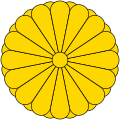Emperor Go-Yōzei facts for kids
Quick facts for kids Emperor Go-Yōzei後陽成天皇 |
|||||
|---|---|---|---|---|---|
 |
|||||
| Emperor of Japan | |||||
| Reign | December 17, 1586 – May 9, 1611 | ||||
| Coronation | January 4, 1587 | ||||
| Predecessor | Ōgimachi | ||||
| Successor | Go-Mizunoo | ||||
| Regent | Toyotomi Hideyoshi | ||||
| Shōguns |
See list
Tokugawa Ieyasu
Tokugawa Hidetada |
||||
| Born | Katahito (周仁) or Kazuhito (和仁) December 31, 1571 Azuchi–Momoyama period |
||||
| Died | September 25, 1617 (aged 45) Heian Palace, Kyoto, Tokugawa shogunate |
||||
| Burial | Fukakusa no kita no Misasagi (深草北陵) Kyoto | ||||
| Spouse |
Konoe Sakiko
(m. 1586) |
||||
| Issue more... |
|
||||
|
|||||
| House | Yamato | ||||
| Father | Prince Masahito | ||||
| Mother | Fujiwara no (Kajūji) Haruko | ||||
| Signature |  |
||||
Emperor Go-Yōzei (後陽成天皇, Go-Yōzei-tennō, December 31, 1571 – September 25, 1617) was the 107th Emperor of Japan. He ruled from 1586 until he stepped down in 1611. His time as emperor saw Japan move from the Azuchi–Momoyama period to the Edo period.
His name, Go-Yōzei, means "Later Emperor Yōzei." He was named after Emperor Yōzei, who lived in the 9th century. The word go- (後) in Japanese means "later" or "the second one."
Contents
Family and Children
Before he became emperor, his personal name was Katahito or Kazuhito. He was the oldest son of Prince Masahito. His grandfather was Emperor Ōgimachi.
Emperor Go-Yōzei lived in the Heian Palace in Kyoto with his family. He had many children. His main wife was Empress Konoe Sakiko.
Here are some of his children with Empress Konoe Sakiko:
- Princess Shōkō (born 1590)
- Imperial Princess Seishi (born 1593), who married Takatsukasa Nobuhisa
- Imperial Prince Kotohito (born 1596), who later became Emperor Go-Mizunoo
- Konoe Nobuhiro (born 1599)
- Imperial Prince Takamatsu-no-miya Yoshihito (born 1603)
- Ichijō Akiyoshi (born 1605)
- Imperial Princess Teishi (born 1606), who married Nijō Yasumichi
He also had many other children with different ladies-in-waiting.
Important Events During Go-Yōzei's Reign
Prince Katahito became emperor when his grandfather, Emperor Ōgimachi, decided to step down. This was a big event because emperors had not abdicated (stepped down) for a long time. It was hard for emperors to abdicate because the country was often in chaos, and there wasn't enough money to support a retired emperor.
His reign was a time of big changes in Japan. It was when the Tokugawa shogunate began. This new government was led by powerful leaders like Tokugawa Ieyasu and Tokugawa Hidetada.
- 1586: Prince Katahito became the Crown Prince. Soon after, his grandfather, Emperor Ōgimachi, stepped down, and Go-Yōzei became emperor.
- 1588: Emperor Go-Yōzei and his father visited Toyotomi Hideyoshi's mansion in Kyoto. This was the first time an emperor had appeared in public since 1521. Hideyoshi was a very powerful leader who had united much of Japan.
- 1590: Hideyoshi led an army to Odawara Castle and defeated the Hōjō clan. This ended a long period of civil war in Japan that had lasted since the Ōnin War (1467–1477).
- 1592: Hideyoshi launched an invasion of Korea, planning to eventually invade China.
- 1598: Toyotomi Hideyoshi died.
- 1600: The Battle of Sekigahara took place. In this battle, the Tokugawa clan and its allies won a major victory, which helped them gain control of Japan.
- 1603: Tokugawa Ieyasu became the shōgun. This officially started the Tokugawa Shogunate, also known as the Edo bakufu. This new government would rule Japan for over 250 years.
- 1605: A new volcanic island, Hachijōko-jima, appeared near Hachijō Island.
- 1606: Construction began on Edo Castle, which would become the center of the new shogunate's power.
- 1609: The Shimazu clan invaded Ryukyu (modern-day Okinawa).
- 1610: The emperor announced he wanted to step down in favor of his son.
- 1611: Emperor Go-Yōzei officially abdicated (stepped down). His son, Prince Masahito, became the new emperor, known as Emperor Go-Mizunoo.
Emperor Go-Yōzei's Impact
Emperor Go-Yōzei's reign happened during the time of Toyotomi Hideyoshi and the start of the Tokugawa Shogunate. He was important because he officially recognized these powerful leaders. This period also allowed the Imperial Family to regain some of its lost power and wealth.
Go-Yōzei gave Toyotomi Hideyoshi the title of Taikō. This was a special title that helped Hideyoshi become even more powerful and stable in his rule.
When Tokugawa Ieyasu became the Sei-i Taishōgun, it was a big step for the Tokugawa family. The emperor's support was important for the shogunate to be seen as legitimate. The shogunate slowly started to get involved in the affairs of the Imperial Court. However, the Imperial Court, which had been very poor during the Warring States Era, started to receive steady financial support from the shogunate.
Emperor Go-Yōzei chose to step down in favor of his third son, Go-Mizunoo. However, he had actually wanted his younger brother, Imperial Prince Hachijō-no-miya Toshihito, to be the next emperor. Prince Toshihito later built the famous Katsura Imperial Villa.
Go-Yōzei loved books and art. He helped publish important Japanese texts using movable type, which was a new technology at the time.
After he abdicated, Go-Yōzei lived for six years in the Sentō Imperial Palace. This palace then became the usual place for retired emperors to live. Emperor Go-Yōzei died on September 25, 1617. He is buried in a special imperial tomb called Fukakusa no kita no misasagi in Kyoto.
Eras During His Reign
The years of Emperor Go-Yōzei's reign are known by these Japanese era names (nengō):
See also
 In Spanish: Go-Yōzei Tennō para niños
In Spanish: Go-Yōzei Tennō para niños
- Emperor of Japan
- List of Emperors of Japan
- Imperial cult
Images for kids
-
Japanese Imperial kamon — a stylized chrysanthemum blossom


